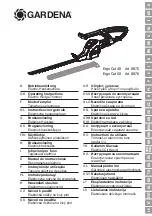
22
Maintenance (continued)
CARBURETOR ADJUSTMENT
The idle speed of the engine is adjustable the screw
next to the air filter cover (Fig 6-15).
NOTE: Careless adjustments can seriously damage
your unit. An authorized service dealer should make
carburetor adjustments.
Check Fuel
Old fuel is usually the main reason for the unit not
running properly. Drain and refill the tank with clean,
fresh unleaded fuel prior to doing any adjustments. See
Section 4, Oil and Fuel
, Recommended Fuel.
Clean Air Filter
The condition of the air filter is important to the opera-
tion of the unit. A dirty air filter will restrict air flow and
change the air/fuel mixture. This is often mistaken for
an out of adjustment carburetor. Check the condition of
the air filter before adjusting the idle speed screw. See
Section 6, Maintenance
, Air Filter Maintenance.
Adjust Idle Speed Screw
The cutting attachment may be spinning during
idle speed adjustment. Wear protective clothing
and observe all safety instructions to prevent
serious personal injury.
If after checking the fuel and cleaning the air filter the
engine still will not idle, adjust the idle speed screw as
follows.
1. Start the engine and let it run at a high idle for a
minute to warm up.
2. Release the throttle trigger and let the engine idle. If
the engine stops, insert a small phillips or flat blade
screwdriver into the screw next to the air filter
cover (Fig. 6-15). Turn the idle speed screw in,
clockwise, 1/8 of a turn at a time (as needed) until
the engine idles smoothly.
NOTE: The cutting attachment should not rotate
when the engine idles.
3. If the cutting attachment rotates when the engine
idles, turn the idle speed screw counterclockwise
1/8 of a turn at a time (as needed), to reduce idle
speed.
Idle
Adjustment
Screw
Checking the fuel mixture, cleaning the air filter, and
adjusting the idle speed screw should solve most
engine problems.
If not and:
•
The engine will not idle,
•
The engine hesitates or stalls on acceleration,
•
There is a loss of engine power,
have the carburetor adjusted by an
authorized service dealer.
When the unit is turned off make sure the cutting
attachment has stopped before the unit is set
down to prevent serious personal injury.
ROCKER ARM CLEARANCE
NOTE: This requires some disassembly of the
engine. If you feel unsure or unqualified to perform
this, take the unit to an authorized service center.
Inspect the valve to rocker arm clearance every 50
hours of operation using a flat feeler gauge.
NOTE: The engine must be cold when checking or
adjusting the valve clearance.
This task should be performed inside, in a clean, dust
free area.
1. Loosen the four (4) screws shown in figure 6-16.
2. Remove the three (3) screws that secure the engine
cover (Figs. 6-16 and 6-17).
3. Disconnect the spark plug wire.
4. Remove the spark plug
5. Remove the engine cover (Fig. 6-16).
6. Remove the screw holding the rocker arm cover
with a large flat blade screwdriver or Torx T25 bit
(Fig. 6-18). Remove the rocker arm cover, and
gasket.
7. Pull the starter rope slowly to bring the piston to
Top Dead Center.
• While looking in the spark plug hole (Fig. 6-18),
the piston is at the top of the stroke.
• Both valves are closed.
• Both rocker arms move freely.
If not, repeat this step.
8. Slide the feeler gauge between the rocker arm and
the valve return spring. Measure the clearance
between the valve stem and rocker arm (Fig 6-19).
Do both intake and exhaust valves.
The recommended clearance for both intake and
exhaust is .003–.006 inch (.076–.0152 mm). The
feeler gauge should slide between the rocker arm and
valve stem with a slight amount of resistance, without
binding.
Fig. 6-15







































